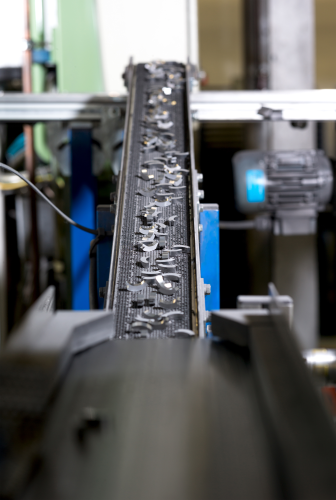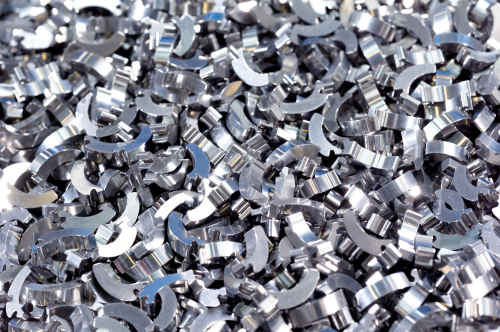

Keiper is a specialist in design and production excellence in metal components and structures for automotive trucks and seats – particularly flexible rear seat structures. In 2011, Keiper was acquired by Johnson Controls, a global leader in automotive seating, interiors and electronics, who is the largest complete seat supplier globally, delivering over 22 million seat sets every year from over 120 seating plants globally.
Back in 1998, Keiper began discussions with GKN about replacing the traditional ‘wedge’ metal components in its backrest adjustment system, called Taumel 2000, with sintered parts. In 2000, a major car manufacturer increased its technical requirements of Keiper, and the company asked GKN’s Bonn plant to help it meet its targets.
“We have been producing products from powder metal at this site since 1934 so there was no problem in terms of process,” said plant manager Matthias Voss. “However, Keiper’s high annual demand of 80 million ‘wedges’ gave us a real headache.”
320,000 components a day
The company decided to put together a cross-functional team to lead the project. Hans-Jürgen Jung, an member of the manufacturing engineering team, and Blaise Akono, today the manager of the manufacturing cell, were both part of the task force.
"We tried to consider all eventualities that might occur, and develop it into a comprehensive manufacturing cell concept, the first here in our plant,” said Jung. “Today, the cell is fully autonomous and forms something of a factory within a factory."
The first volume production order was issued by the OEM in 2000. It comprised 100,000 units per week and manufacturing at Bonn started with one press and three employees.
Due to the high product quality the orders were rapidly increased and Akono had to expand the production capacity to the current level of seven presses within just one year.
"If I had known at that time that my team and I were to produce 320,000 components each day, I would hardly have considered it possible,” said Akono. “However, we have independently developed the various processes required and improved them continuously.
“Besides well-known manufacturing steps this included a special surface processing method, which did not exist before in powder metal technology. The development of this process was the biggest challenge in this project. At the same time it was evidence of the impressive innovative power of the Bonn production site."
Quality assurance
By 2001 the Bonn plant had delivered 25 million wedges to Keiper, and within four years the deliveries were already at 300 million parts, all with zero defects. Currently, the manufacturing cell now operates in three shifts with a total of ten workers. The manufacturing process include pressing, sintering, hardening, tempering, vibratory finishing, drying and hardness testing, while a complex camera system helps ensure a 100% quality inspection. A special feature is that the parts are produced in three different dimensions that cannot be visually distinguished. Therefore, the final step involves automatic sorting and packaging of the different variants.
“The quality assurance concept has been constantly refined,” said Voss.“The hardness is checked by an eddy current system. Subsequently the parts are fed into the sorting unit in the correct position so that the cameras can check the dimensional accuracy and surface finish of the components. Defective parts are sorted out by the system and we have now reached one billion parts with zero defects.
“This success story was made possible by a consistent zero defect strategy from the beginning,” he added.
Currently the company has follow-up projects both in production and on the verge of starting volume production, including more complex components.
“We are very optimistic about the future, especially as the benefits of powder metal technology increasingly come into view of development engineers and production managers,” concluded Voss.
The most common PM process, often referred to as conventional PM processing – involves compressing metal powder in a precision tool set and then heating it to form metallurgical bonds. The resulting sintered part is very often the end product and secondary operations are not necessary, one of the main benefits of powder metallurgy. The PM process also conserves natural resources by utilizing recycled raw materials. A low emission manufacturing process and avoiding or minimizing wasteful secondary operations, further minimise environmental impact.
The raw material powder is pressed or compacted in a closed die to form the near-net-shape (identical to or very similar to final dimensions) “green" compact. These compacts are subsequently heated in a continuous sintering furnace to an elevated temperature and in a protective atmosphere in order to form metallurgical integrity. Consistency is assured by applying precise temperature and atmospheric controls.
Although the majority of products are manufactured from material compositions defined by national or international standards, GKN also focuses extensively on the development of unique materials for specialized applications.
The GKN Sinter Metals division comprises 28 production facilities with more than 6,000 employees worldwide. GKN offers a range of different manufacturing techniques involving PM. These include:
Conventional compaction of selected metal powders on powder presses using ‘closed-loop’ technology. This ensures densities above 7.2 g/cc with a homogeneous material structure. The ‘closed-loop’ method allows geometries such as undercuts or the innovative ‘green-in-green’ technology. The surface density is further improved by a subsequent sizing operation.
Warm compaction which can achieve a density of more than 7.35 g/cc. The powder has been engineered to be compacted in heated tooling. Again, the ‘closed-loop’ process is used.
Selective rolling. This helps to achieve full density in highly stressed contact areas of the drivetrain component. Helical gears can be provided with a heavy-duty surface area and an elastic core with a supporting strength to optimise application performance.






